Implications of Human Activities, Land Use Changes and Climate Variability in Mediterranean Lakes of Greece
Abstract
:1. Introduction
2. Materials and Methods
2.1. Description of the Study Area
2.2. Climate Data
2.3. Water Level and Chemistry Data
2.4. Satellite Image Pre-Processing and Interpretation of Satellite Image Time Series
2.5. Relationships between Climate, Water Level, Water Chemistry, Land Cover/Uses and Landscape Changes
3. Results
3.1. Impact of Climate Variability on the Water Level
3.2. Change in Lake Area and Reed Beds
3.3. Landscape Changes
3.4. Inter-Annual Changes of Water Chemistry Parameters
4. Discussion
5. Conclusions—Implications for Restoration
Acknowledgments
Author Contributions
Conflicts of Interest
References
- Shi, P.; Ma, X.; Hou, Y.; Li, Q.; Zhang, Z.; Qu, S.; Chen, C.; Cai, T.; Fang, X. Effects of Land-Use and Climate Change on Hydrological Processes in the Upstream of Huai River, China. Water Resour. Manag. 2013, 27, 1263–1278. [Google Scholar] [CrossRef]
- Russell, J.M.; McCoy, S.J.; Verschuren, D.; Bessems, I.; Huan, Y.G. Human impacts, climate change, and aquatic ecosystem response during the past 2000 yr at Lake Wandakara, Uganda. Quat. Res. 2009, 72, 315–324. [Google Scholar] [CrossRef]
- Waters, M.N.; Piehler, M.F.; Rodriguez, A.B.; Smoak, J.M.; Bianchi, T.S. Shallow lake trophic status linked to late Holocene climate and human impacts. J. Paleolimnol. 2009, 42, 51–64. [Google Scholar] [CrossRef]
- Nielsen, A.; Trolle, D.; Sǿndergaard, M.; Lauridsen, T.; Bjerring, R.; Olensen, J.E.; Jeppesen, E. Watershed land use effects on lake water quality in Denmark. Ecol. Appl. 2012, 22, 1187–1200. [Google Scholar] [CrossRef] [PubMed]
- Nikouei, A.; Zibael, M.; Ward, F. Incentives to adopt irrigation water saving measures for wetlands preservation: An integrated basin scale analysis. J. Hydrol. 2012, 464–465, 216–232. [Google Scholar] [CrossRef]
- Fraterrigo, J.M.; Downing, J.A. The Influence of Land Use on Lake Nutrients Varies with Watershed Transport Capacity. Ecosystems 2008, 11, 1021–1034. [Google Scholar] [CrossRef]
- Pulido-Velasquez, M.; Peña-Haro, S.; Morcholi-Almudever, A.F.; Henriquez-Dole, L.; Macian-Sorribes, H.; Lopez-Nicolas, A. Integrated assessment of the impact of climate and land use changes of groundwater quantity and quality in the Mancha Oriental system (Spain). Hydrol. Earth Syst. Sci. 2015, 19, 1677–1693. [Google Scholar] [CrossRef]
- Kløve, B.; Ala-Aho, P.; Bertrand, G.; Gurdak, J.J.; Kupfersberger, H.; Kvoerner, J.; Muotka, T.; Mykrä, H.; Preda, E.; Rossi, P.; et al. Climate Change Impacts on Groundwater and Dependent Ecosystems. J. Hydrol. 2014, 518, 250–266. [Google Scholar] [CrossRef]
- Papastergiadou, E.; Retalis, A.; Kalliris, P.; Georgiadis, T. Land use changes and associated environmental impacts on the Mediterranean shallow lake Stymfalia, Greece. Hydrobiologia 2007, 584, 361–372. [Google Scholar] [CrossRef]
- Papastergiadou, E.S.; Retalis, A.; Apostolakis, A.; Georgiadis, T. Environmental Monitoring of Spatio-temporal Changes Using Remote Sensing GIS in a Mediterranean Wetland of Northern Greece. Water Resour. Manag. 2008, 22, 579–594. [Google Scholar] [CrossRef]
- Papastergiadou, E.; Kagalou, I.; Stefanidis, K.; Retalis, A.; Leonardos, I. Effects of Anthropogenic Influence on the Trophic State, Land Use and Aquatic Vegetation in a Shallow Mediterranean Lake: Implications for Restoration. Water Resour. Manag. 2010, 24, 415–435. [Google Scholar] [CrossRef]
- Jeppesen, E.; Brucet, S.; Naselli-Flores, L.; Papastergiadou, E.; Stefanidis, K.; Nõges, T.; Nõges, P.; Attayde, J.L.; Zohary, T.; Coppens, J.; et al. Ecological impacts of global warming and water abstraction on lakes and reservoirs due to changes in water level and related changes in salinity. Hydrobiologia 2015, 750, 201–227. [Google Scholar] [CrossRef]
- Coops, H.; Beklioglu, M.; Crisman, T.L. The role of water-level fluctuations in shallow lake ecosystems–workshop conlusions. Hydrobiologia 2003, 506–509, 23–27. [Google Scholar] [CrossRef]
- Beklioglu, M.; Romo, S.; Kagalou, I.; Quintana, X.; Bѐcares, E. State of the art in the functioning of shallow Mediterranean lakes: Workshop conclusions. Hydrobiologia 2007, 584, 317–326. [Google Scholar] [CrossRef]
- Pilgrim, C.M.; Mikhailova, E.A.; Post, C.J.; Hains, J.J. Spatial and Temporal analysis of land cover changes and water quality in the Lake Issaqueena watershed, South Carolina. Environ. Monit. Assess. 2014, 186, 7617–7630. [Google Scholar] [CrossRef] [PubMed]
- Zhang, F.; Tiyip, T.; Johnson, V.C.; Kung, H.; Ding, J.; Sun, Q.; Zhou, M.; Kelimu, A.; Nurmuhammat, I.; Chan, N.W. The influence of natural and human factors in the shrinking of the Ebinur Lake, Xinjiang, China, during the 1972–2013 period. Environ. Monit. Assess. 2015, 187, 4128. [Google Scholar] [CrossRef] [PubMed]
- Otáhelová, H.; Oahe, J.; Pazúr, J.; Hrivnák, R.; Valachovič, M. Spatio-temporal changes in land cover and aquatic macrophytes of the Danube floodplain lake. Limnologica 2011, 41, 316–324. [Google Scholar] [CrossRef]
- Skoulikidis, N.; Kaberi, H.; Sakellariou, D. Patterns, origin, and possible effects of sediment pollution in a Mediterranean lake. Hydrobiologia 2008, 613, 71–83. [Google Scholar] [CrossRef]
- Gianniou, S.K.; Antonopoulos, V.Z. Evaporation and energy budget in Lake Vegoritis, Greece. J. Hydrol. 2007, 345, 212–223. [Google Scholar] [CrossRef]
- Thornthwaite, C.W. An approach toward a rational classification of climate. Geogr. Rev. 1948, 38, 55–94. [Google Scholar] [CrossRef]
- United Nations Environment Programme. World Atlas of Desertification; Edward Arnold: London, UK, 1992. [Google Scholar]
- Bonte, M.; Zwolsman, J.G. Climate change induced salinisation of artificial lakes in the Netherlands and consequences for drinking water production. Water Res. 2010, 44, 4411–4424. [Google Scholar] [CrossRef] [PubMed]
- Müller, B.; Gächter, R. Increasing chloride concentrations in Lake Constance: Characterization of sources and estimation of loads. Aquat. Sci. 2012, 74, 101–112. [Google Scholar] [CrossRef]
- U.S. Geological Survey. Landsat Imagery; U.S. Geological Survey, Earth Resources Observation & Science Center (EROS): Sioux Falls, SD, USA, 2009.
- Vittek, M.; Brink, A.; Donnay, F.; Simonetti, D.; Desclée, B. Land cover change monitoring using Landsat MSS/TM Satellite Image Data over West Africa between 1975 and 1990. Remote Sens. 2014, 6, 658–676. [Google Scholar] [CrossRef]
- Hadjimitsis, D.G.; Clayton, C.R.I.; Retalis, A. Darkest pixel atmospheric correction algorithm: A revised procedure for environmental applications of satellite remotely sensed imagery. In Proceedings of the 10th International Symposium on Remote Sensing, Barcelona, Spain, 8 September 2003.
- Hadjimitsis, D.G.; Papadavid, G.; Agapiou, A.; Themistocleous, K.; Hadjimitsis, M.G.; Retalis, A.; Michaelides, S.; Chrysoulakis, N.; Toulios, L.; Clayton, C.R.I. Atmospheric correction for satellite remotely sensed data intended for agricultural applications: Impact on vegetation indices. Nat. Hazards Earth Syst. Sci. 2010, 10, 89–95. [Google Scholar] [CrossRef]
- ENVI Software, version 4.7; ITT Corporation: Westchester, NY, USA, 2009.
- ERDAS Imagine 9.2, Leica Geosystems Geospatial Imaging: Norcross, GA, USA, 2008.
- McFeeters, S.K. The use of the Normalized Difference Water Index (NDWI) in the delineation of open water features. Int. J. Remote Sens. 1996, 17, 1425–1432. [Google Scholar] [CrossRef]
- Wang, J.D.; Sheng, Y.W.; Tong, T.S.D. Monitoring decadal lake dynamics across the Yangtze Basin downstream of Three Gorges Dam. Remote Sens. Environ. 2014, 152, 251–269. [Google Scholar] [CrossRef]
- McGarigal, K.; Marks, B.J. FRAGSTATS: Spatial Pattern Analysis Program for Quantifying Landscape Structure; U.S. Forest Service General Technical Report; Oregon State University: Corvallis, OR, USA, 1995. [Google Scholar]
- Feidas, H.; Noulopoulou, C.; Makrogiannis, T.; Bora-Senta, E. Trend analysis of precipitation time series in Greece and their relationship with circulation using surface and satellite data: 1955–2001. Theor. Appl. Climatol. 2007, 87, 155–177. [Google Scholar] [CrossRef]
- Nastos, P.T.; Politi, N.; Kapsomenakis, J. Spatial and temporal variability of the Aridity Index in Greece. Atmos. Res. 2013, 119, 140–152. [Google Scholar] [CrossRef]
- Almutairi, A.; Warner, A.T. Change detection accuracy and image properties: A study using simulated data. Remote Sens. 2010, 2, 1508–1529. [Google Scholar] [CrossRef]
- Serra, P.; Pons, X.; Sauri, D. Post-classification change detection with data from different sources: Some accuracy considerations. Int. J. Remote Sens. 2003, 24, 3311–3340. [Google Scholar] [CrossRef]
- Stefanidis, K.; Papastergiadou, E. Influence of hydrophyte abundance on the spatial distribution of zooplankton in selected lakes of Greece. Hydrobiologia 2010, 656, 55–65. [Google Scholar] [CrossRef]
- Stefanidis, K.; Papastergiadou, E. Effects of a long term water level reduction on the ecology and water quality in an eastern Mediterranean lake. Knowl. Manag. Aquat. Ecosyst. 2013, 411, 05. [Google Scholar] [CrossRef]
- Schaldach, R.; Koch, J.; der Beek, T.A.; Kynast, E.; Flörke, M. Current and future irrigation water requirements in pan-Europe: An integrated analysis of socio-economic and climate scenarios. Glob. Planet. Chang. 2011, 94, 33–45. [Google Scholar] [CrossRef]
- Kagalou, I.; Leonardos, I. Typology, classification and management issues of Greek lakes: Implication of the water framework directive (2000/60/EC). Environ. Monit. Assess. 2009, 150, 469–484. [Google Scholar] [CrossRef] [PubMed]
- Drakou, E.G.; Kallimanis, A.S.; Sgardelis, S.P.; Pantis, J.D. Landscape structure and habitat composition in reservoirs, lakes and rivers. Lake Reserv. Manag. 2008, 24, 244–260. [Google Scholar] [CrossRef]
- Kruess, A.; Tscharntke, T. Habitat fragmentation, species loss, and biological control. Science 1994, 264, 1581–1584. [Google Scholar] [CrossRef] [PubMed]
- Downing, J.A.; McCauley, E. The nitrogen: Phosphorus relationship in lakes. Limnol. Oceanogr. 1992, 37, 936–945. [Google Scholar] [CrossRef]
- Haidary, A.; Bahman, J.A.; Adamowski, A.; Fohrer, N.; Nakane, K. Assessing the impacts of four land use types on the water quality of wetlands in Japan. Water Resour. Manag. 2013, 27, 2217–2229. [Google Scholar] [CrossRef]
- Nielsen, D.L.; Brock, M.A. Modified water regime and salinity as a consequence of climate change: Prospects for wetlands of Southern Australia. Clim. Chang. 2009, 95, 523–533. [Google Scholar] [CrossRef]
- Wichelns, D.; Oster, J.D. Sustainable irrigation is necessary and achievable, but direct costs and environmental impacts can be substantial. Agric. Water Manag. 2006, 86, 114–127. [Google Scholar] [CrossRef]
- Beklioglu, M.; Altinayar, G.; Tan, C.O. Water level control over submerged macrophyte development in five shallow lakes of Mediterranean Turkey. Arch. Hydrobiol. 2006, 166, 535–556. [Google Scholar] [CrossRef]
- Datta, K.K.; Tewari, L.; Toshi, P.K. Impact of subsurface drainage on improvement of crop production and farm income in northwest India. Irrig. Drain. Syst. 2004, 18, 43–55. [Google Scholar] [CrossRef]
- Latinopoulos, D. Estimating the Potential Impacts of Irrigation Water Pricing Using Multicriteria Decision Making Modelling. An Application to Northern Greece. Water Resour. Manag. 2008, 22, 1761–1782. [Google Scholar] [CrossRef]
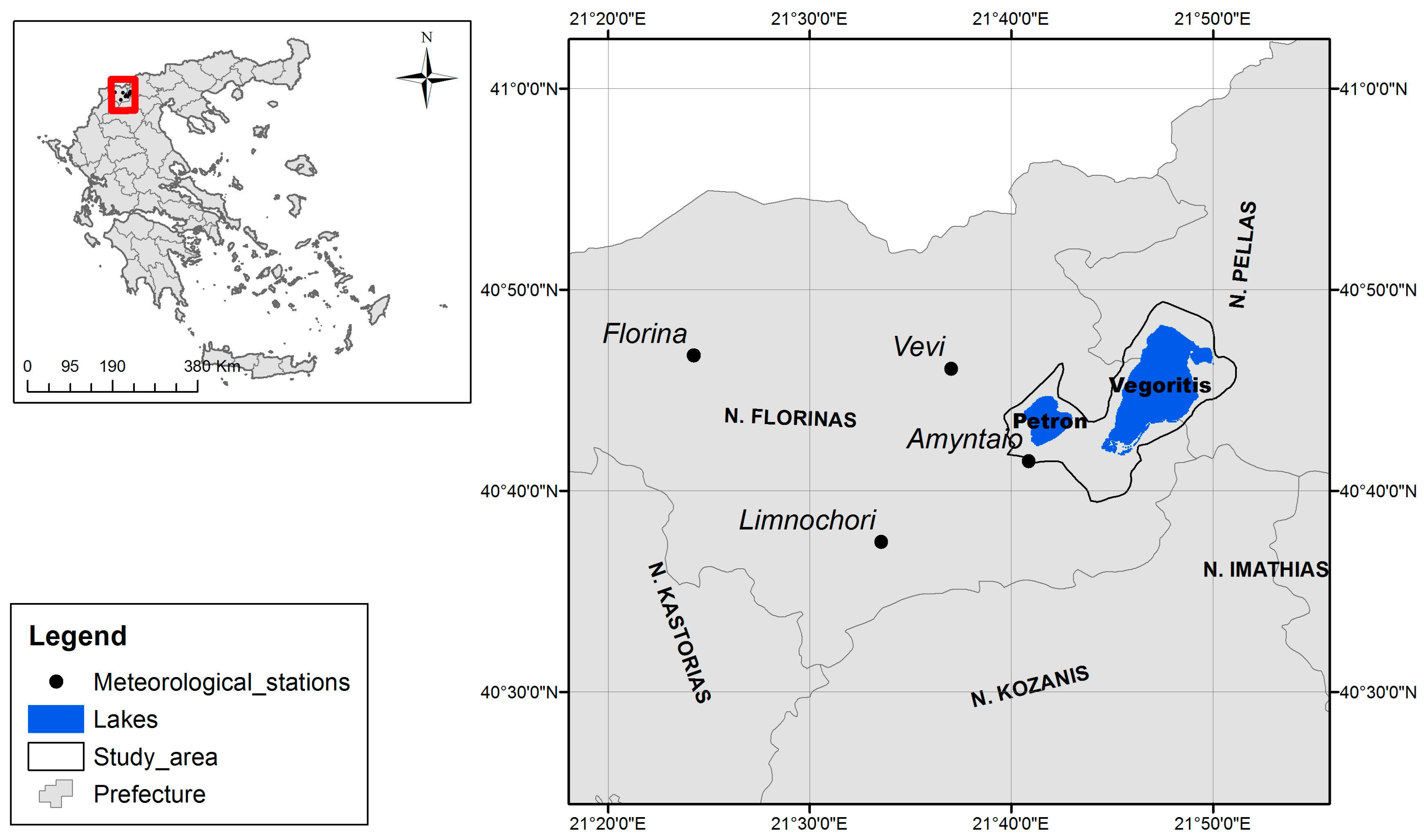
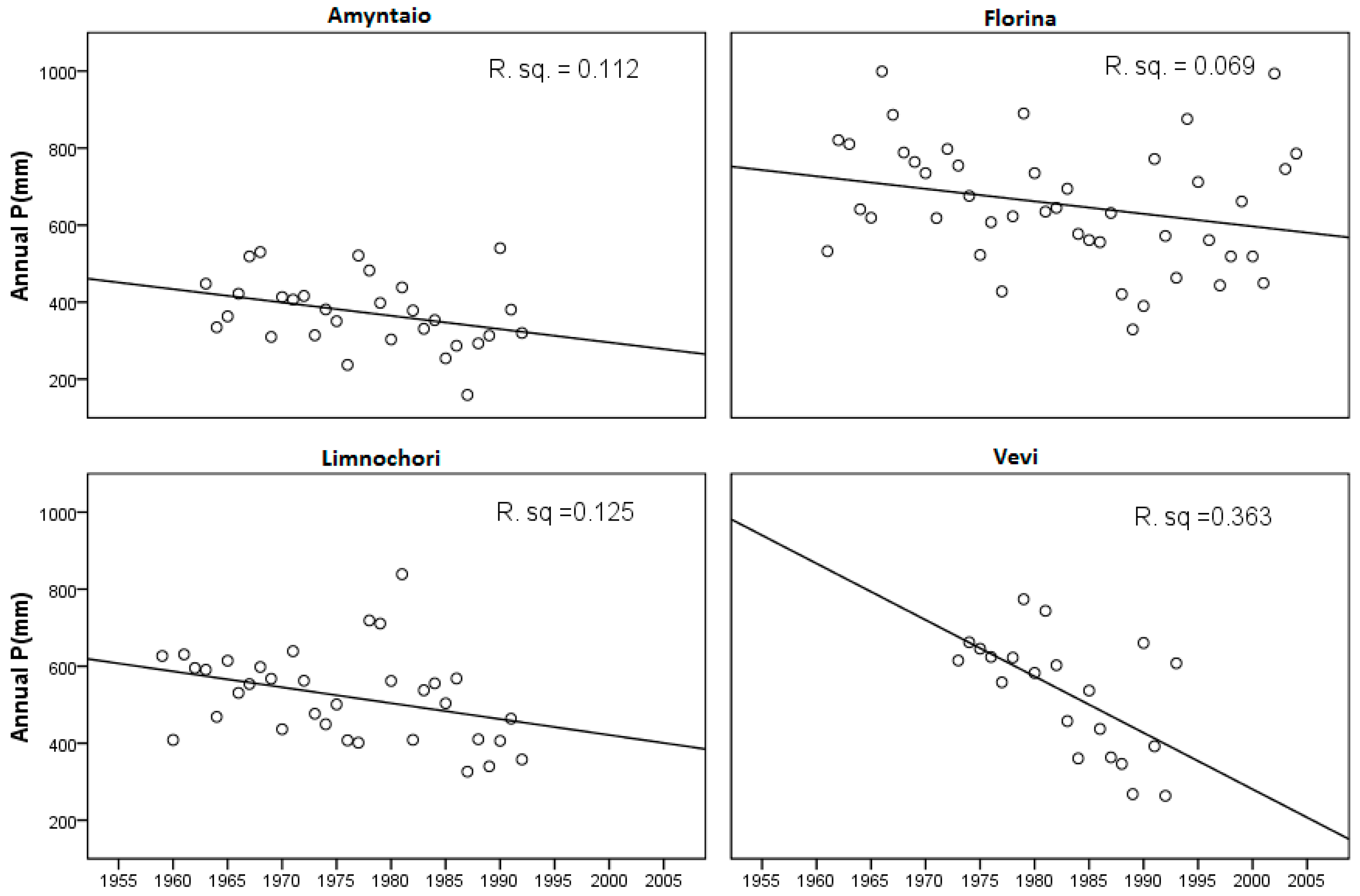
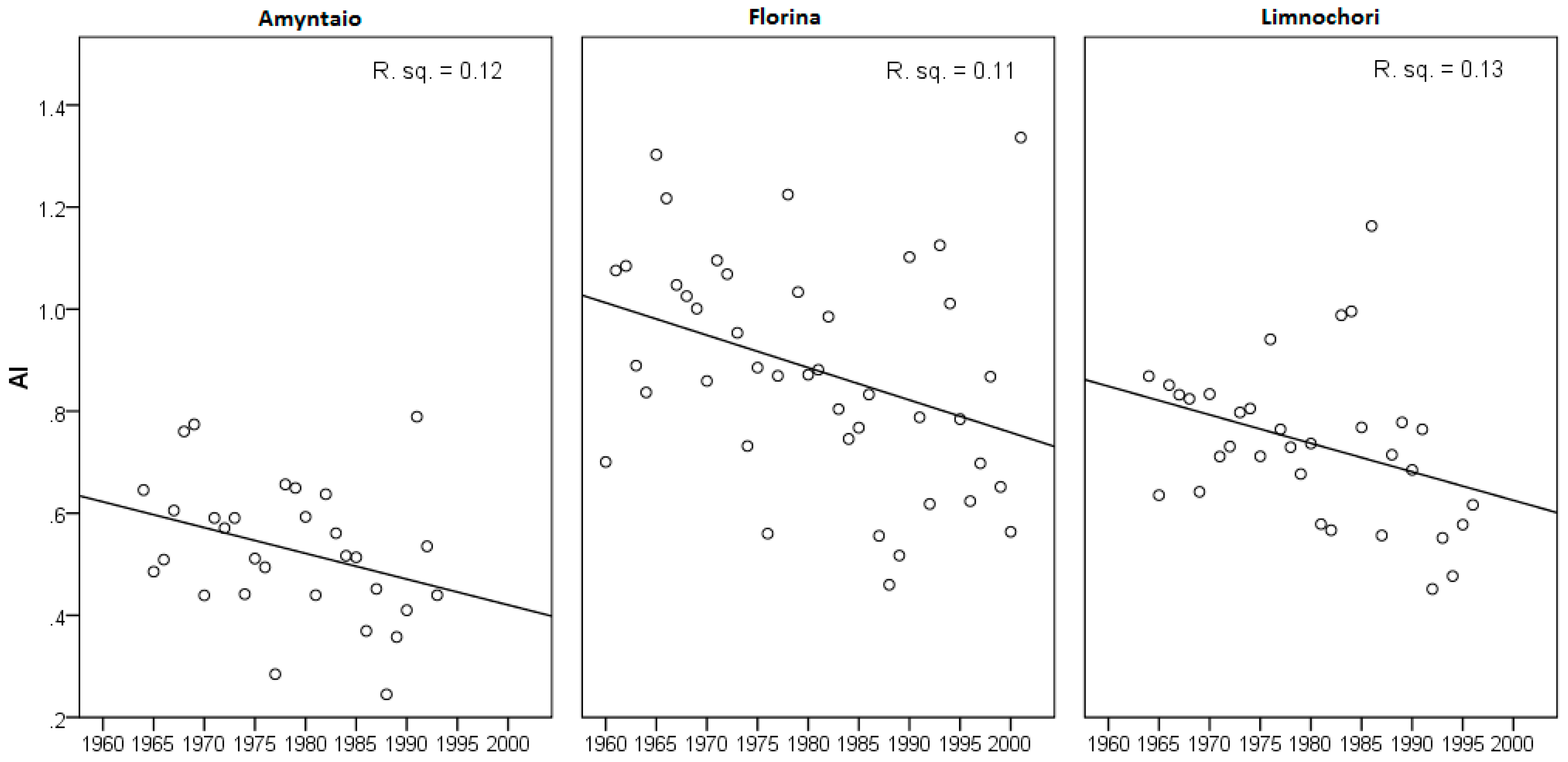
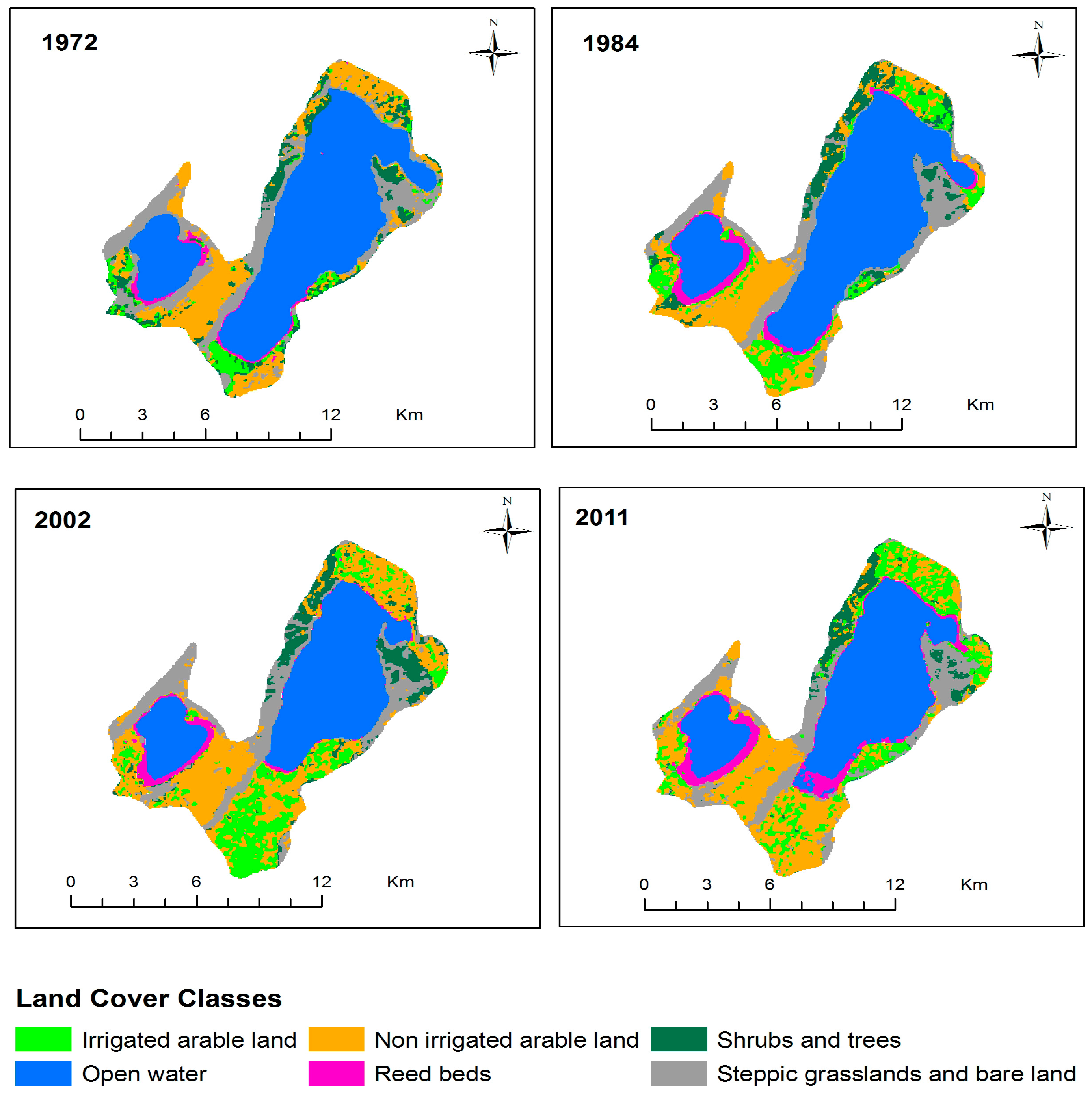
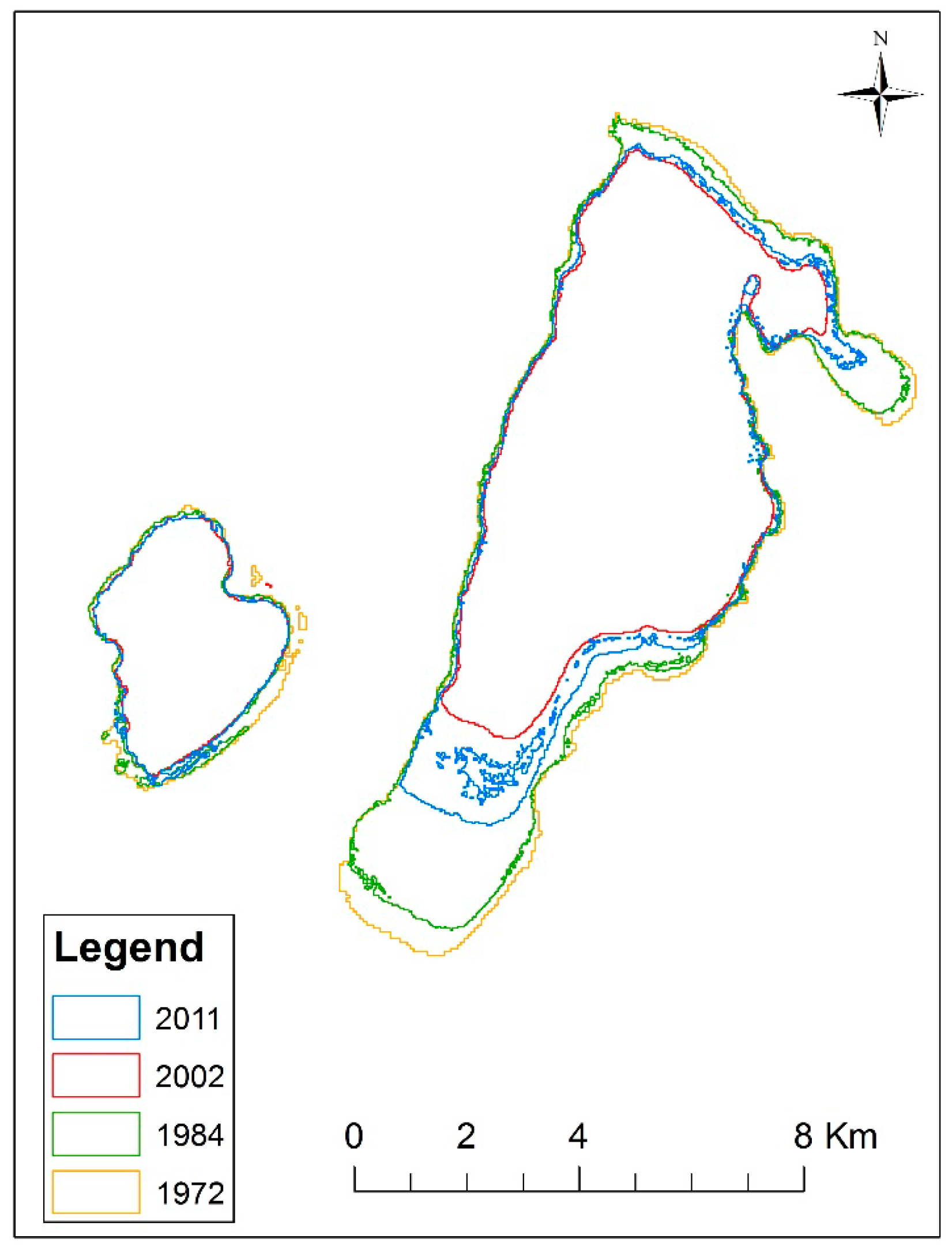
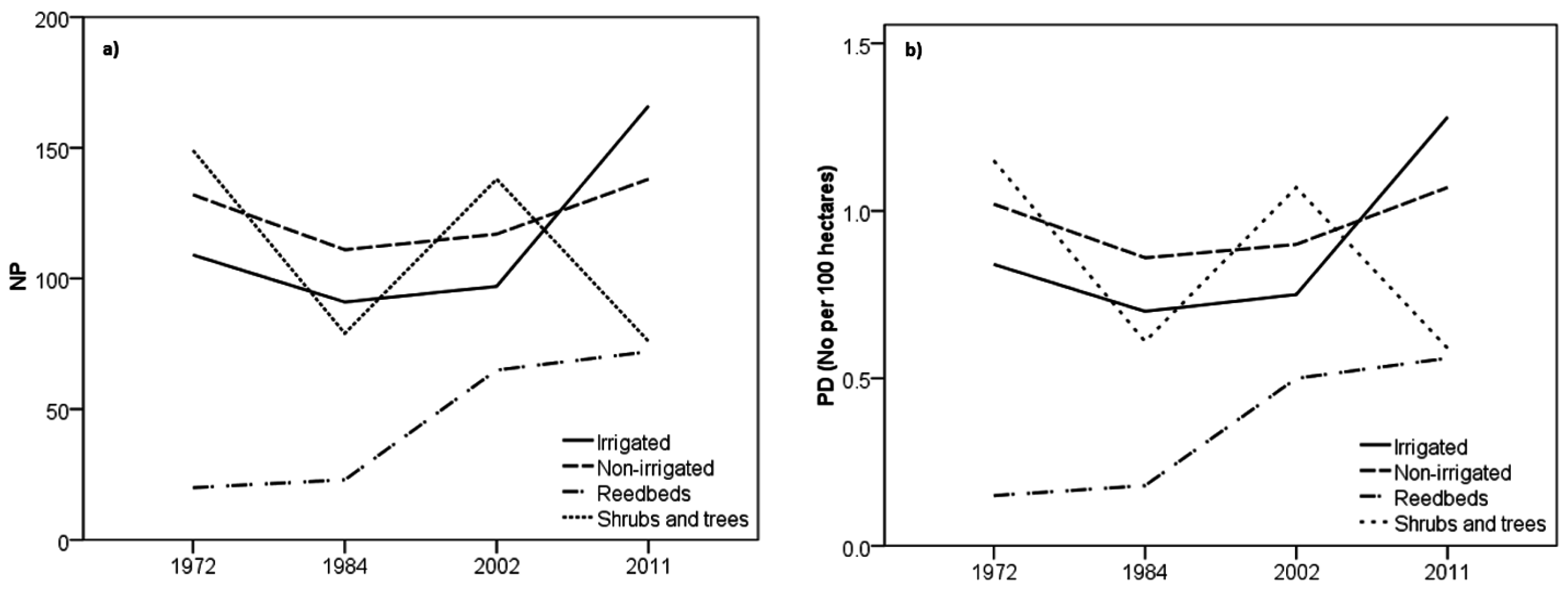
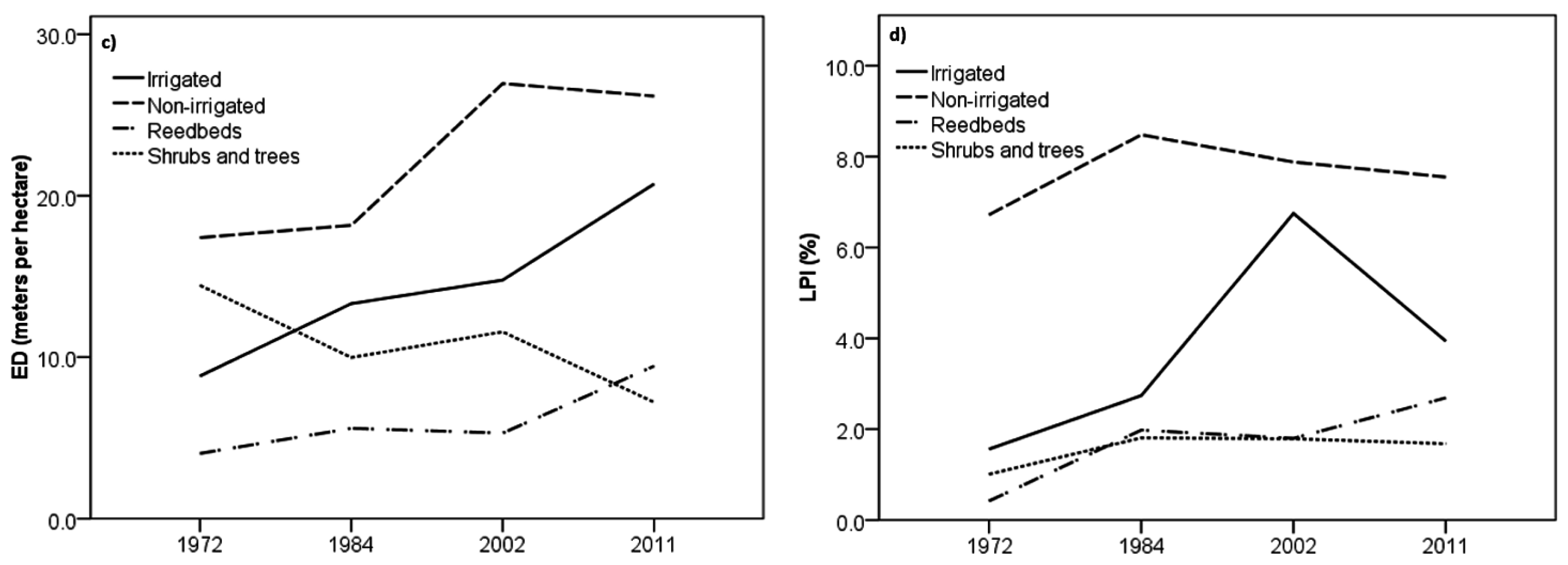
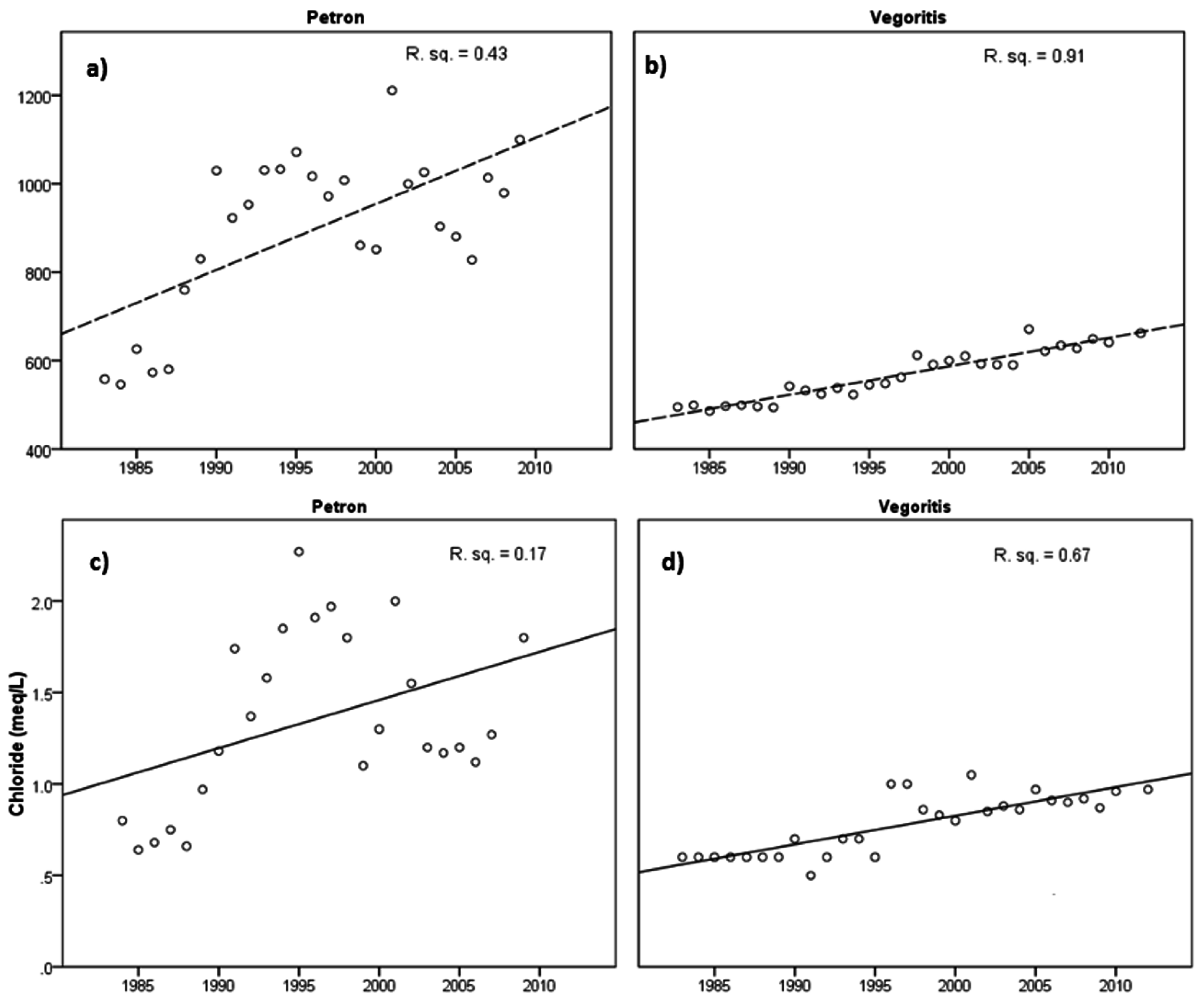
| Climatic Zone | P/PET (Thornthwaite Method) |
|---|---|
| Hyper-arid | <0.05 |
| Arid | 0.05–0.2 |
| Semi-arid | 0.2–0.5 |
| Sub-humid | 0.5–0.65 |
| Humid | >0.65 |
| Land Cover/Land Use Types | Description |
|---|---|
| Open water | Open water area of lakes, possibly containing submerged macrophytes close to the littoral zone |
| Irrigated arable land | Agricultural land mostly cultivated by crops irrigated by the lakes (e.g., vineyards) |
| Non irrigated arable land | Agricultural land containing crops that are not irrigated |
| Reed beds | Reeds dominated by associations of Phragmitetalia and small patches of calcareous fens with Cladium mariscus and Carex spp. |
| Shrubs and trees | Mostly class of Quercetea pubescentis including associations consisting of Quercus trojana, Carpinus orientalis and Juniperus oxycedrus |
| Steppic grasslands and bare land | Bare land, hills, rocks, and dry calcreous grassland vegetation dominated by the class Festuco-Brometea |
| Parameter | r Coef. and p Significance Level | P (Amyntaio) | PET (Amyntaio) | AI (Amyntaio) | P (Florina) | PET (Florina) | AI (Florina) | P (Limnochori) | PET (Limnochori) | AI (Limnochori) | WL |
|---|---|---|---|---|---|---|---|---|---|---|---|
| P (Amyntaio) | Cor. Coef. | 1 | 0.448 * | 0.129 | 0.321 | 0.288 | 0.647 ** | 0.314 | 0.028 | –0.043 | 0.249 |
| Sig. | 0.015 | 0.505 | 0.083 | 0.123 | 0 | 0.091 | 0.885 | 0.825 | 0.185 | ||
| PET (Amyntaio) | Cor. Coef. | 1 | −0.229 | −0.211 | 0.002 | 0.345 | −0.138 | −0.064 | −0.127 | −0.115 | |
| Sig. | 0.223 | 0.264 | 0.992 | 0.062 | 0.474 | 0.736 | 0.504 | 0.543 | |||
| AI (Amyntaio) | Cor. Coef. | 1 | 0.674 ** | −0.314 | 0.311 | 0.426 * | −0.162 | −0.022 | 0.258 | ||
| Sig. | 0 | 0.091 | 0.094 | 0.021 | 0.392 | 0.908 | 0.169 | ||||
| P (Florina) | Cor. Coef. | 1 | −0.045 | 0.293 | 0.370 * | −0.068 | 0.093 | 0.333 * | |||
| Sig. | 0.778 | 0.063 | 0.037 | 0.707 | 0.608 | 0.029 | |||||
| PET (Florina) | Cor. Coef. | 1 | 0.307 | 0.052 | 0.26 | −0.284 | −0.036 | ||||
| Sig. | 0.051 | 0.777 | 0.143 | 0.109 | 0.823 | ||||||
| AI (Florina) | Cor. Coef. | 1 | 0.645 ** | −0.065 | −0.154 | 0.374 * | |||||
| Sig. | 0 | 0.719 | 0.392 | 0.016 | |||||||
| P (Limnochori) | Cor. Coef. | 1 | −0.277 | 0.013 | 0.398 * | ||||||
| Sig. | 0.145 | 0.947 | 0.024 | ||||||||
| PET (Limnochori) | Cor. Coef. | 1 | 0.035 | −0.031 | |||||||
| Sig. | 0.845 | 0.864 | |||||||||
| AI (Limnochori) | Cor. Coef. | 1 | 0.506 ** | ||||||||
| Sig. |
| Land Use/Class | 1972 | 1984 | 2002 | 2011 | ||||
|---|---|---|---|---|---|---|---|---|
| – | Area (ha) | % | Area (ha) | % | Area (ha) | % | Area (ha) | % |
| Open water/Lake Petron | 1046 | 8 | 959 | 7 | 924 | 7 | 913 | 7 |
| Open water/Vegoritis | 5608 | 43 | 5266 | 41 | 3676 | 28 | 4014 | 31 |
| Open water/Total | 6654 | 51 | 6225 | 48 | 4600 | 36 | 4927 | 38 |
| Irrigated arable land | 557 | 4 | 1149 | 9 | 1672 | 13 | 1570 | 12 |
| Non irrigated arable land | 2185 | 17 | 2233 | 17 | 3248 | 25 | 3060 | 24 |
| Reed beds | 206 | 2 | 468 | 4 | 352 | 3 | 785 | 6 |
| Shrubs and trees | 945 | 7 | 904 | 7 | 951 | 7 | 591 | 5 |
| Steppic grasslands and bare land | 2398 | 19 | 1970 | 15 | 2127 | 16 | 2015 | 16 |
| Land Use/Class | 1972–1984 | 1984–2002 | 2002–2011 | 1972–2011 | ||||
|---|---|---|---|---|---|---|---|---|
| – | % Change | Annual Change (ha/Year) | % Change | Annual Change (ha/Year) | % Change | Annual Change (ha/Year) | % Change | Annual Change (ha/Year) |
| Open water/Lake Petron | −8.3 | −10.9 | −3.6 | −1.9 | −1.2 | −1.2 | −12.7 | −3.4 |
| Open water/Vegoritis | −6.1 | −42.8 | −30.2 | −88.3 | 9.2 | 37.6 | −28.4 | −40.9 |
| Open water/Total | −6.4 | −53.6 | −26.1 | −90.3 | 7.1 | 36.3 | −26.0 | −44.3 |
| Irrigated arable land | 106.3 | 74.0 | 45.5 | 29.1 | −6.1 | −11.3 | 181.9 | 26.0 |
| Non irrigated arable land | 2.2 | 6.0 | 45.5 | 56.4 | −5.8 | −20.9 | 40.0 | 22.4 |
| Reed beds | 127.2 | 32.8 | −24.8 | −6.4 | 123.0 | 48.1 | 281.1 | 14.8 |
| Shrubs and trees | −4.3 | −5.1 | 5.2 | 2.6 | −37.9 | −40.0 | −37.5 | −9.1 |
| Steppic grasslands and bare land | −17.8 | −53.5 | 8.0 | 8.7 | −5.3 | −12.4 | −16.0 | −9.8 |
© 2016 by the authors; licensee MDPI, Basel, Switzerland. This article is an open access article distributed under the terms and conditions of the Creative Commons Attribution (CC-BY) license (http://creativecommons.org/licenses/by/4.0/).
Share and Cite
Stefanidis, K.; Kostara, A.; Papastergiadou, E. Implications of Human Activities, Land Use Changes and Climate Variability in Mediterranean Lakes of Greece. Water 2016, 8, 483. https://doi.org/10.3390/w8110483
Stefanidis K, Kostara A, Papastergiadou E. Implications of Human Activities, Land Use Changes and Climate Variability in Mediterranean Lakes of Greece. Water. 2016; 8(11):483. https://doi.org/10.3390/w8110483
Chicago/Turabian StyleStefanidis, Konstantinos, Aikaterini Kostara, and Eva Papastergiadou. 2016. "Implications of Human Activities, Land Use Changes and Climate Variability in Mediterranean Lakes of Greece" Water 8, no. 11: 483. https://doi.org/10.3390/w8110483
APA StyleStefanidis, K., Kostara, A., & Papastergiadou, E. (2016). Implications of Human Activities, Land Use Changes and Climate Variability in Mediterranean Lakes of Greece. Water, 8(11), 483. https://doi.org/10.3390/w8110483








